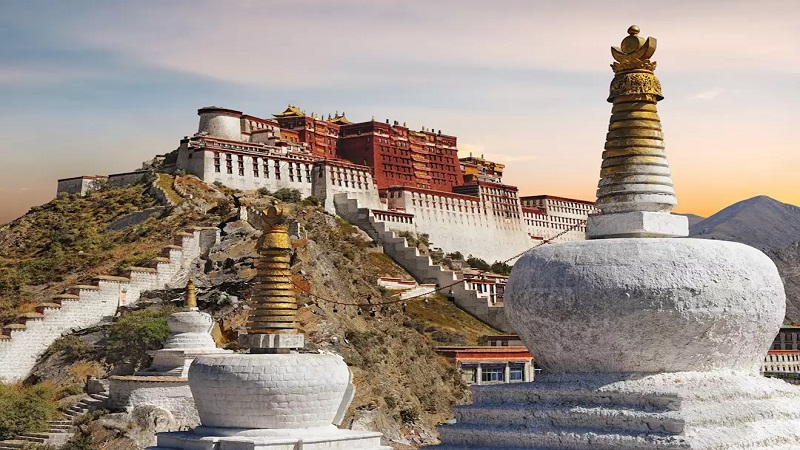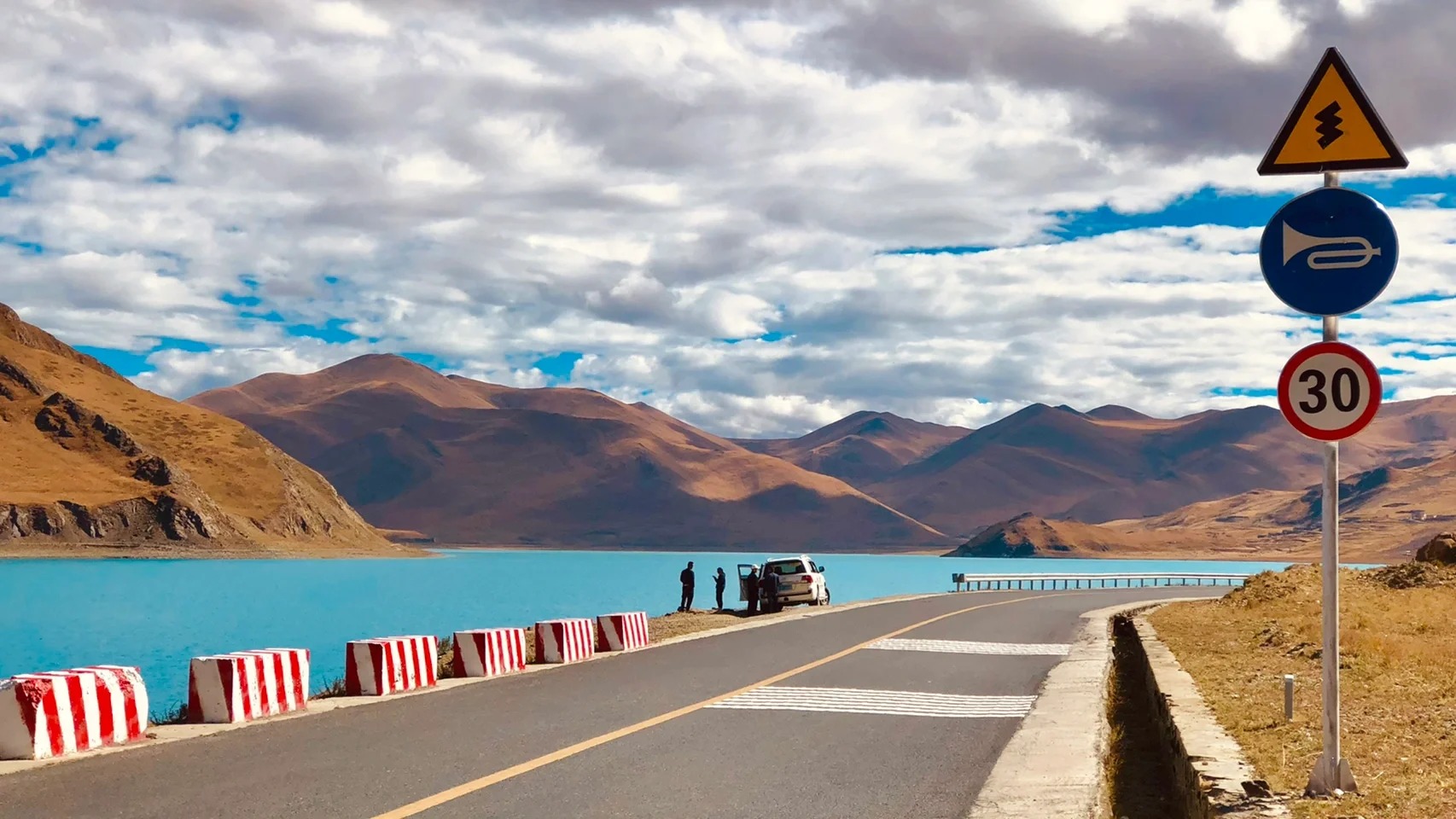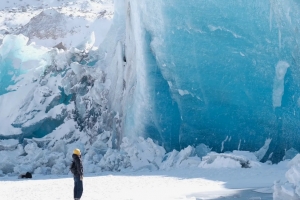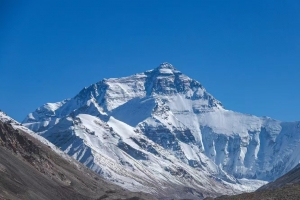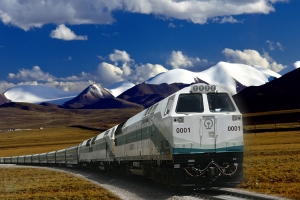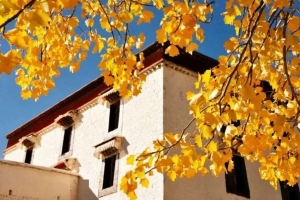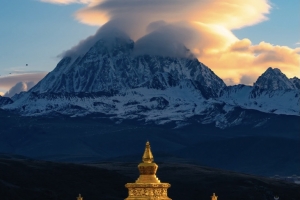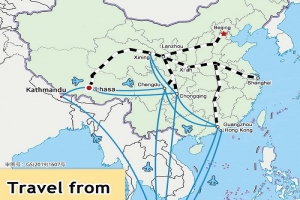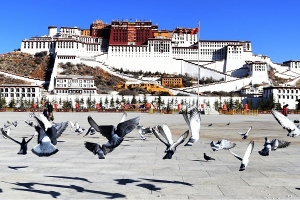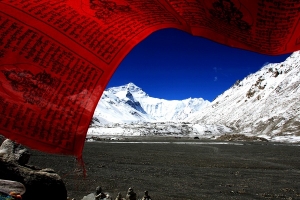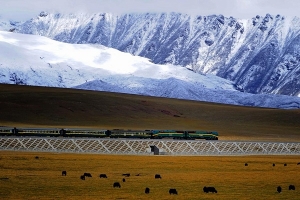Lhasa, the ancient and spiritual capital of Tibet, beckons travelers with its breathtaking landscapes, rich cultural heritage, and mystic allure. Whether you’re drawn to the golden-domed Potala Palace, the sacred Jokhang Temple, or simply the serene beauty of the high-altitude plateau, reaching Lhasa is an adventure in itself. In this comprehensive guide, we will explore five of the best ways to travel to Lhasa by air, rail, and road. This guide is designed to help you choose the best route for your journey, while ensuring you have all the essential information to plan an unforgettable trip.
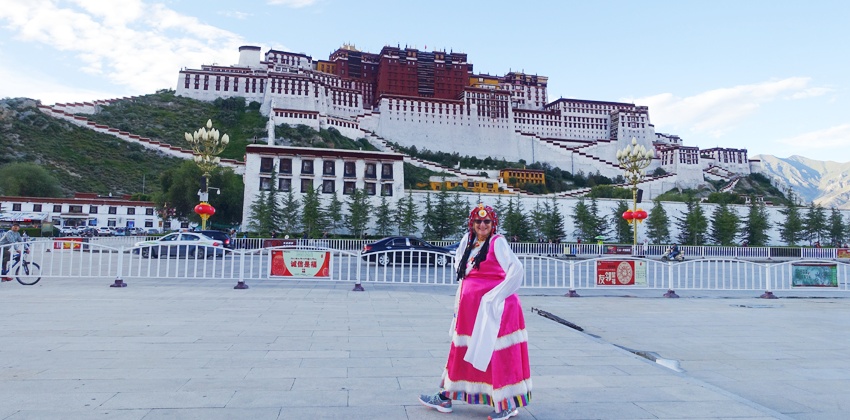
Why Travel to Lhasa?
Lhasa stands at the crossroads of history, spirituality, and natural wonder. Nestled high on the Tibetan Plateau, this city offers an immersion into a world where ancient traditions blend seamlessly with the rugged beauty of nature. For many travelers, reaching Lhasa is not merely about the destination but the journey itself—a pilgrimage of discovery through diverse landscapes and cultures.
Traveling to Lhasa can be a challenge due to its altitude and geographic isolation, but modern transport options have made the journey more accessible than ever. Whether you have a tight schedule, a desire for scenic travel, or an appetite for adventure, there is a route tailored to your needs. In the sections that follow, we explore five primary methods of reaching Lhasa, each with its unique advantages, challenges, and unforgettable experiences.
Option 1: Flying from Mainland China
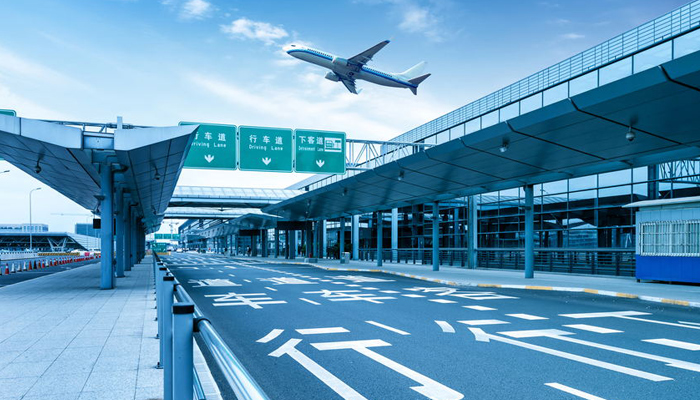
Air travel remains one of the most popular methods for getting to Lhasa, especially for those with limited time. With more than 20 cities in mainland China offering direct flights to Lhasa Gonggar Airport, tourists can choose from a variety of departure points to suit their travel itinerary.
Popular Departure Cities
Major Chinese cities such as Beijing, Shanghai, Chengdu, Xi’an, Chongqing, Kunming, Xining, and Guangzhou all provide direct routes to Lhasa. Among these, Chengdu is often considered the most efficient departure hub. Chengdu not only offers frequent flights—sometimes more than 20 departures a day—but also has one of the shortest flight durations, averaging around 2.5 hours to Lhasa.
Flight Duration and Costs
While flight times vary depending on the departure city, they generally range from 2 to 7 hours. Although airfares may seem slightly higher compared to other modes of travel, the convenience and significant time savings make flying an attractive option for many. Economy class tickets typically range from approximately $250 to $285, making this method particularly appealing during peak tourist seasons when time is of the essence.
Advantages of Flying
- Speed: Ideal for travelers who want to maximize their time in Lhasa.
- Convenience: Direct flights from numerous major cities simplify planning.
- Frequency: Increased flight options during peak seasons reduce the likelihood of sold-out seats.
- Comfort: Modern aircraft offer a comfortable journey, allowing you to relax and acclimatize once you arrive.
Flying from mainland China provides a fast and hassle-free way to reach Lhasa, especially when compared to longer train rides or overland journeys. It is an excellent choice if you’re looking to begin your exploration of Tibet as quickly as possible.
Option 2: International Flights from Kathmandu
For travelers coming from outside of China, the option to fly directly into Tibet is limited. Kathmandu, Nepal, offers the only non-stop international flight to Lhasa, making it a unique gateway for international visitors eager to experience the Tibetan plateau.
Flight Schedule and Duration
Flights from Kathmandu to Lhasa generally operate on a set schedule, departing three times per week—typically on Monday, Wednesday, and Friday mornings. Despite the infrequency compared to mainland routes, this option is prized for its efficiency. The journey is remarkably short, with flight durations averaging between 1 hour and 10 minutes to 1 hour and 20 minutes.
Scenic Views En Route
An added allure of the Kathmandu-Lhasa flight is the dramatic view it provides of the Himalayan range. As you soar above rugged terrains, you might catch glimpses of the world’s highest peaks, including an awe-inspiring view of Mount Everest. This aerial journey transforms a simple flight into a visual feast, setting the tone for your Tibetan adventure.
Ticket Pricing and Booking
Economy class tickets from Kathmandu start at around $490. While the cost may be higher compared to domestic flights, the direct route and the scenic aspect of the journey add considerable value, making it an attractive option for international travelers.
Key Considerations
- Limited Frequency: With only a few flights per week, booking in advance is crucial.
- Unique Experience: The flight offers rare international access to Tibet, combined with stunning Himalayan vistas.
- Direct Access: Avoids the need for multiple layovers or transfers, simplifying the travel process.
Flying directly from Kathmandu provides an exciting and efficient entry into Tibet, particularly for those already in the South Asian region or seeking a unique perspective on the Himalayas.
Option 3: Scenic Train Journeys via the Qinghai-Tibet Railway
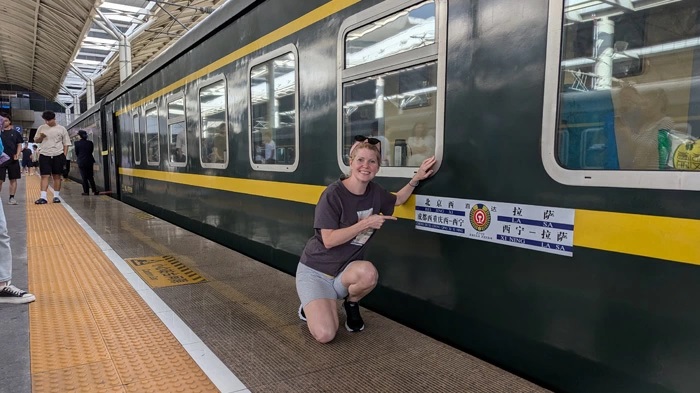
If you have a bit more time and a passion for scenic travel, the train journey to Lhasa via the Qinghai-Tibet Railway is an experience that transcends the simple act of moving from one place to another. This route is not just about reaching your destination; it’s about immersing yourself in one of the world’s most dramatic landscapes.
Gateway Cities and Routes
The Qinghai-Tibet Railway connects Lhasa to several major cities in China, including Beijing, Shanghai, Xining, Guangzhou, Xi’an, Chongqing, and Chengdu. Each route provides a different perspective of the vast Tibetan plateau, varying in duration from 22 to 53 hours. Every journey promises a unique mix of cultural encounters and breathtaking natural vistas.
Highlights of the Qinghai-Tibet Railway
- Xining – The Journey’s Starting Point: The train departs from Xining, the gateway to the Tibetan plateau, and soon ascends into higher altitudes, presenting travelers with a gradual acclimatization to the region’s unique environment.
- World Records and Engineering Marvels: As you traverse the highest railway in the world, you’ll pass through engineering feats such as the highest railway station and the longest tunnel constructed through permafrost. These innovations are testaments to human ingenuity in the face of extreme conditions.
- Stunning Scenery: The route offers panoramic views of Qinghai Lake, the snow-dusted Kunlun Mountains, and the rugged expanses of the Qiangtang Grassland. Nature enthusiasts will find endless opportunities for photography and reflection as the landscape transforms before your eyes.
Cabin Classes and Comfort
For optimal comfort during this lengthy journey, consider choosing a hard sleeper berth. This option provides a balance between cost and comfort. Hard sleeper cabins, which typically accommodate six travelers per compartment, allow you to rest comfortably as you glide across the breathtaking scenery of Tibet. Prices start as low as $69 for shorter routes from Xining and may reach up to $120 for longer journeys from cities like Guangzhou.
The Allure of Rail Travel
Traveling by train offers a relaxed pace, allowing you to observe the dramatic changes in landscape over several hours. It is an excellent choice for those who appreciate slow travel and wish to experience the cultural and natural splendors of Tibet in a more intimate manner. Moreover, the train ride often provides opportunities to mingle with local travelers and exchange stories, making the journey a rich tapestry of shared experiences.
Option 4: Overland Adventure from Kathmandu
For those who crave adventure and a deeper immersion into the natural beauty of the region, traveling overland from Kathmandu to Lhasa is an experience like no other. This route is a favorite among adventurers and photography enthusiasts, as it offers an up-close encounter with the dramatic landscapes of the Himalayas and the Tibetan plateau.
The Route Explained
The overland journey from Kathmandu covers approximately 943 kilometers, following the historic Sino-Nepal Friendship Highway. This scenic route takes you from the bustling city of Kathmandu to the remote and serene landscapes of Tibet. Key segments of the journey include:
- Kathmandu to Rasuwa Gadi: The adventure begins with a 130-kilometer drive from Kathmandu to Rasuwa Gadi, the Nepal-China border. This section of the route is known for its winding roads and rugged terrain, setting the tone for the challenges and rewards that lie ahead.
- Border Crossing at Gyirong: After reaching the border, you will cross into Tibet via the Gyirong Border. This transition from Nepal to Tibet is both exciting and symbolic, as it marks the beginning of your true Tibetan adventure.
- Highlights Along the Way: Once in Tibet, the journey continues along well-maintained roads that offer views of some of the region’s most iconic sites, including:
- Everest Base Camp: Although not directly on the route, some tours incorporate a detour to offer a glimpse of the world’s highest mountain.
- Shigatse: Tibet’s second-largest city, rich in history and cultural significance.
- Yamdrok Lake: One of Tibet’s most sacred lakes, known for its striking turquoise waters.
Unique Experiences and Challenges
Traveling overland allows you the flexibility to stop wherever your heart desires. Whether it’s pausing to capture the perfect photograph, sampling local Tibetan cuisine, or simply taking in the vast, open landscapes, this route offers a level of freedom that scheduled flights and trains cannot match. However, it is important to be well-prepared:
- Road Conditions: While many sections are paved, certain stretches can be bumpy and challenging, requiring a robust vehicle and an experienced driver.
- Altitude and Weather: The high altitude of the plateau can affect both vehicles and travelers. Acclimatization, proper hydration, and having the right gear for varying weather conditions are essential.
- Border Formalities: Ensure that all travel documents and permits are in order before embarking on this journey, as border crossings require careful attention to regulations.
Why Choose the Overland Route from Kathmandu?
Opting for an overland journey from Kathmandu is ideal for those who prefer a hands-on travel experience. It combines the thrill of adventure with the opportunity to explore hidden gems along the way. This route is especially appealing for:
- Adventurers: Those who relish the unpredictability of road travel and the opportunity to engage directly with the local environment.
- Photographers and Nature Lovers: The constantly changing scenery offers unparalleled opportunities for photography and observation.
- Cultural Enthusiasts: Overland travel provides deeper insights into local life, as you interact with people in remote communities and witness traditions that have persisted for centuries.
Option 5: Road Trips from Mainland China
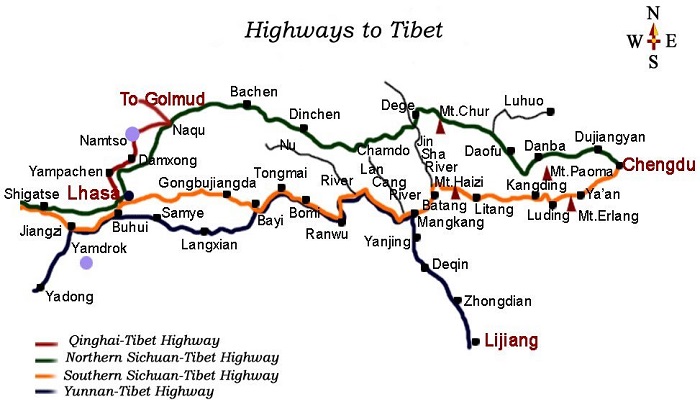
For those based in mainland China or seeking an alternative to air travel, overland routes to Lhasa offer an excellent blend of adventure, flexibility, and immersive experiences. Several distinct road trip routes allow you to tailor your journey to your interests and starting location. The most popular options include routes from Chengdu, Kunming, Xining, and Urumqi.
The Sichuan-Tibet Highway
From Chengdu to Lhasa:
The Sichuan-Tibet Highway is one of the most celebrated routes, extending approximately 2,115 kilometers. Departing from Chengdu, this route takes you on a dramatic ascent through the Hengduan Mountains before entering the vast expanses of the Tibetan plateau. Along the way, you’ll encounter:
- Diverse Landscapes: Transition from lush, green valleys to rugged, arid highlands as you climb in altitude.
- Scenic Marvels: Discover Nyingchi Prefecture—often referred to as the “Switzerland of Tibet”—with its verdant forests, sparkling rivers, and charming Tibetan villages.
- Cultural Experiences: Stop at local towns to savor authentic Tibetan cuisine, participate in cultural festivals, and gain insights into the traditional way of life.
The Qinghai-Tibet Highway
From Xining to Lhasa:
Another highly recommended route is the Qinghai-Tibet Highway, which parallels the famous Qinghai-Tibet Railway in terms of scenic beauty and historical significance. Spanning roughly 1,947 kilometers, this route crosses the formidable Kunlun and Tanggula mountain ranges, with an impressive portion—over 1,200 kilometers—of the road set at elevations above 4,000 meters. Travelers on this route will be captivated by:
- Panoramic Views: Marvel at the sweeping vistas of the Qiangtang grasslands and catch glimpses of holy sites such as Lake Namtso.
- Adventure on High Altitude Roads: Experience the challenge and thrill of driving on roads that twist and turn through some of the world’s most inhospitable yet beautiful terrains.
- Flexibility: Unlike scheduled train journeys, a road trip allows you to pause and explore off-the-beaten-path attractions at your own pace.
Planning a Road Trip
Embarking on a road trip to Lhasa from mainland China requires careful planning. Here are some essential tips to ensure a smooth journey:
- Timing is Everything: Choose the best season to travel. Avoid the rainy season to minimize the risk of landslides and road closures.
- Vehicle Preparation: Ensure that your vehicle is well-maintained and equipped to handle high-altitude driving. A 4WD vehicle is often recommended.
- Navigation and Communication: Modern GPS systems and mobile connectivity (where available) are indispensable. However, be prepared with offline maps as some areas may have limited service.
- Cultural Sensitivity: Respect local customs and traditions, especially when passing through remote Tibetan villages. Engaging with local communities can add a rich dimension to your trip.
- Safety Gear: Carry emergency supplies, extra food and water, and be prepared for sudden weather changes.
The Joy of the Open Road
Traveling overland from mainland China is more than just a mode of transport—it is a journey that allows you to savor every moment of the route. The freedom to stop, explore, and experience the land in its raw, natural state makes road trips an appealing option for many travelers. Whether you are a seasoned road tripper or planning your first long-distance drive, this journey to Lhasa promises memories that will last a lifetime.
Essential Travel Permits and Documentation
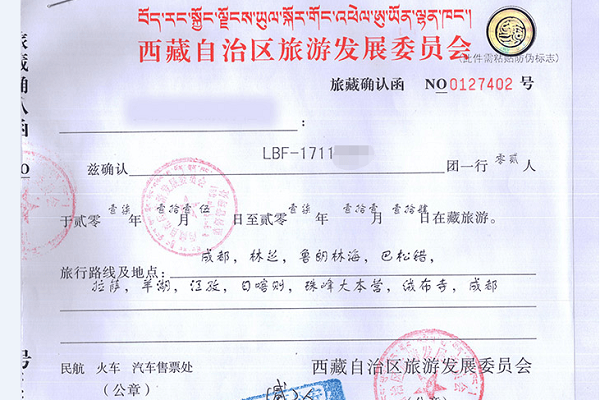
Before you embark on your journey to Lhasa, it is crucial to ensure that all your travel permits and documents are in order. Due to the sensitive nature of the region, all travelers must obtain a Tibet Travel Permit. This document is mandatory for entering Tibet and must be arranged in advance.
How to Obtain a Tibet Travel Permit
- Application Process: The Tibet Travel Permit is not something you can simply pick up on arrival; it requires prior application. If you have a Chinese visa, you’ll need to provide copies along with your valid passport to the appropriate agency or travel service.
- Processing Time: Allow ample time for processing, as delays can occur. It is advisable to start the application process several weeks before your planned departure.
- For International Travelers: If you are entering Tibet from Nepal, the procedure involves obtaining a Chinese Group Visa rather than a standard Chinese visa. This additional requirement must be coordinated with your travel agent or visa service.
- Assistance: Many tour operators and travel agencies offer services to help secure the Tibet Travel Permit. Utilizing their expertise can save you time and ensure that your application is completed correctly.
Other Required Documents
- Chinese Visa/Group Visa: Depending on your point of entry, ensure that your visa is valid for the duration of your stay and covers the necessary regions.
- Identification: Always carry your passport and any other required identification documents while traveling in Tibet.
- Local Permits: In some cases, additional local permits may be required for visits to certain areas. Check in advance if you plan to explore regions beyond Lhasa.
⇒ Contact us to get free Tibet Travel Permit information.
Planning Your Lhasa Journey: Tips and Tricks

Traveling to Lhasa is an adventure that requires careful preparation, not only in terms of logistics but also for personal comfort and safety. Here are some key tips to help you prepare for the journey:
Acclimatization
- Allow Time to Adjust: Lhasa sits at an altitude of over 3,600 meters (nearly 12,000 feet). Give yourself at least a day or two upon arrival to acclimatize before embarking on strenuous activities.
- Stay Hydrated: Drink plenty of water to help your body adjust to the high altitude.
- Medication: Consider consulting your doctor about altitude sickness medication if you’re prone to such issues.
Packing Essentials
- Clothing: Bring layers of clothing, as temperatures can vary dramatically between day and night. Even in summer, mornings and evenings can be chilly.
- Sun Protection: High altitudes mean stronger UV rays, so don’t forget sunglasses, sunscreen, and a hat.
- Comfort Items: Whether you’re taking a long train ride or a road trip, having comfortable travel gear, including a neck pillow and a light blanket, can make a big difference.
Health and Safety
- Travel Insurance: Make sure you have comprehensive travel insurance that covers high-altitude travel and medical emergencies.
- Local Emergency Contacts: Familiarize yourself with local emergency services and, if possible, learn a few basic phrases in Tibetan or Mandarin to facilitate communication.
- Stay Informed: Check weather forecasts and road conditions regularly, especially if you’re traveling overland. Local travel apps and news sources can be helpful.
Cultural Sensitivity and Local Etiquette
- Respect Local Customs: Tibet is a region rich in tradition and spirituality. When visiting religious sites or local villages, dress modestly and behave respectfully.
- Engage with Locals: If you get the opportunity, interact with local Tibetans. Their hospitality and knowledge can provide insights that guidebooks may miss.
- Learn a Few Phrases: Even basic greetings in Tibetan or Mandarin can go a long way in building rapport and showing respect.
Happy Lhasa Journey
With its stunning natural landscapes, vibrant cultural heritage, and the palpable sense of history, Lhasa promises a travel experience that will resonate with you long after you return home. The diverse options—ranging from the speed and convenience of air travel to the immersive, slowly unfolding narratives of train and road journeys—ensure that every traveler can find a path that suits their style and schedule. As you plan your journey, remember that preparation is key: secure your travel permits well in advance, acclimatize to the altitude, and always keep an open mind to the rich tapestry of experiences that await you.
Happy travels, and may your journey to Lhasa be filled with discovery, inspiration, and unforgettable moments. Contact us to get free advice on Lhasa travel.

